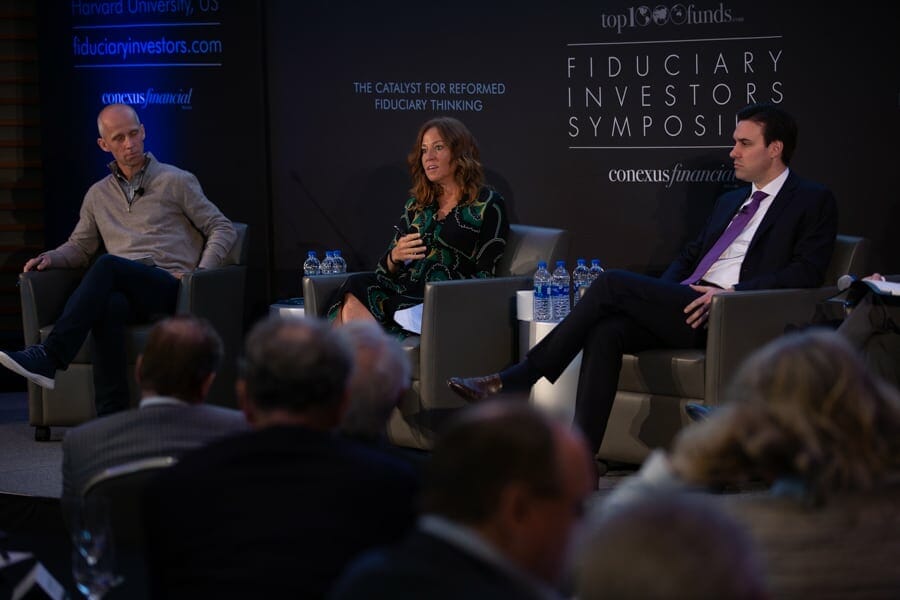Startlingly few institutional investors have allocations to life sciences. An informal poll of 85 asset owners from 20 countries responsible for a combined $9 trillion assets under management gathered at the Fiduciary Investors’ Symposium at Harvard University, found only a tiny handful active in the sector. The few included Lakeview Capital Management, a single-family office with a 17 per cent allocation to biotech, and France’s €33 billion ($36 billion) Fonds de Réserve pour les Retraites (FRR) which has allocated around €80 million to a private equity venture capital fund focused on biotech.
The ensuing discussion of the risk that accompanies life sciences investment helps put the figure in context. It is volatile, requires sector specialism and long-term commitments out to 15 years, calling for “a different perception of returns,” Chris Winiarz, chief investment officer, Lakeview Capital Management told delegates.
Yet allocating to biotech makes an important contribution to society – investing in the sector can help change lives. None more so than in gene therapy, the cutting-edge corner of biomedicine that works on one-time cures for some of the world’s cruellest diseases.
It’s a “sweet spot” of healthcare investment, said Debra Netschert, health sciences equity portfolio manager and research analyst, Jennison, who said its ability to “fix the machinery of our body” is transformational for sufferers.
Netschert told delegates that the sector is fast growing, and “multiple companies” in the field make following its evolution “hard work.”
The product cycles and investment horizons are long, and treating humans requires a particular kind of “thoughtfulness.”
Fellow panellist Nick Leschley, chief executive, Bluebird Bio which develops pioneering gene therapies for severe genetic diseases and cancers, told delegates that the technology “is starting to work” and that “kids are alive that shouldn’t be.”
He also warned of the unknowns in the sector, particularly around regulation and timeline. “Expectation and patience are of fundamental importance,” he warned.
Costs
One of the biggest unknowns is how the cost of gene therapy and its accompanying pricing model will evolve.
It involves developing a system that allows everyone to access gene therapy, but also recognises that treatments cost “hundreds of thousands of dollars” and can’t be handed out for free.
He predicted gene therapy will disrupt pricing models with challenging ramifications “as big as the science.”
He told delegates that companies in the sector need “enough to fund innovation, but not be egregious.”
Rather than “extort the system” because of the transforming significance of gene therapy cures, he said the system needs a different model that supports continued growth and rewards innovation, but which is also balanced.
“We all need to be responsible in engaging in this dialogue,” he told delegates.
One way to evaluate its worth is by assessing “the value to the system” of one-time cures, whereby “patients live a full life” and can contribute to society once again.
He suggested that payments could be spread over patients’ lifetimes whereby they “pay a certain amount each year for life,” only paying if the treatment works.
The idea “should be thrown out there” so that the system “is forced to consider it,” leading to a “thoughtful” collaborative dialogue, he said. Moreover, any roll out of gene therapy is complicated by different healthcare systems around the world, like the US’s insurance-based system or the German model where “everyone is covered,” said Leschley.
Valuing biotech
Valuing biotech companies is just as challenging. Positively, it is relatively easy to see if therapies are working, said Netschert.
“When you give a gene therapy you see its effects quickly. Things in the blood tell you if it’s working.”
This leads to spikes in company valuations early on, but she warned investors to be careful of “delusions of grandeur” and to guard against thinking that things will “happen quickly.” Investment requires patience, knowledge and understanding of the manufacturing process and management team.
“A large part of the valuation is the management team,” she says. “Really great mangers can do great things with an average asset, and bad managers can destroy a great asset.”
She also advised investors in the sector to be nimble, warning against paying for over-valued assets, but playing with the size of their positions and being thoughtful about risk. “If you are holding something long duration, you can adjust the size over time,” she said.
Long-term
Leschley told delegates that investors had to prepare for backward steps in this cutting-edge, entrepreneurial sector.
He said management teams “fell down but got back up stronger” driven by a passionate culture and mindset particular to biomedicine.
“This is all we care about – there is no other disease area for us,” he said. He also told investors to prepare for the long-term.
“I am not going to calm you down over near-term anxiety. I talk long-term.”
Moreover, he added that companies that raise too much money too fast “lose their hunger” and that a “lack of footing and lack of comfort” is important for innovation.
Sentiments echoed by Winiarz, who told delegates that it was vital companies understand that they have access to permanent capital.
“You have to imagine what a company will look like in ten years-time,” he said, concluding: “We don’t have Bloomberg terminals.”




